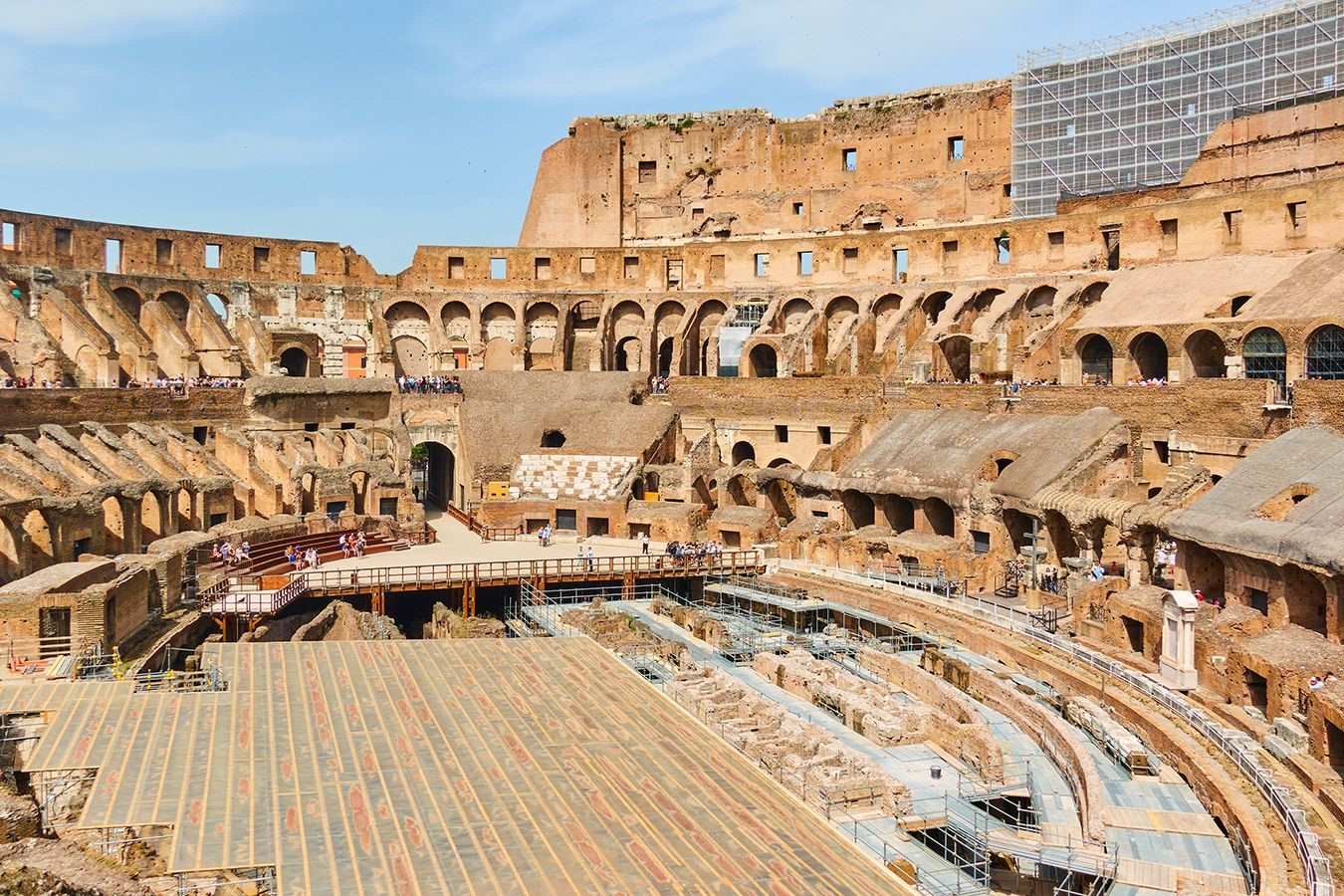
Why does Ancient Roman Concrete still fascinate us today? The secret lies in its incredible durability and unique composition. Developed over 2,000 years ago, Roman concrete, or opus caementicium, was a game-changer in construction. This ancient material, made from lime, volcanic ash, and various aggregates, has outlasted many modern structures. Its ability to withstand harsh environments, including saltwater, and its self-healing properties make it a marvel of ancient engineering. From the iconic Pantheon to enduring aqueducts, Roman concrete showcases the ingenuity of Roman builders. Let's explore 35 intriguing facts about this ancient wonder and understand why it remains a subject of admiration and study.
Key Takeaways:
- Ancient Roman concrete, known as opus caementicium, revolutionized construction with its durability and self-healing properties. Its use of volcanic ash and lime set it apart from modern concrete.
- Roman concrete, developed over 2,000 years ago, still stands today in iconic structures like the Pantheon and Colosseum. Its unique composition and self-healing capabilities make it a marvel of ancient engineering.
Ancient Roman Concrete: A Marvel of Engineering
Ancient Roman concrete, known as opus caementicium, has fascinated historians and engineers for centuries. Despite being developed over 2,000 years ago, its durability and strength continue to inspire modern construction. Let's dive into the fascinating world of Roman concrete with these 35 facts.
The Roman Architectural Revolution
The Roman Architectural Revolution, also called the Concrete Revolution, marked a significant leap in construction techniques. This period saw the rise of arches, bridges, aqueducts, domes, and vaults, all made possible by Roman concrete.
- Roman concrete was a crucial component in the construction of ancient Roman structures, including buildings, bridges, and aqueducts.
- The Roman Architectural Revolution began around 509 BC with the establishment of the Roman Republic.
- This period saw significant advancements in construction techniques, including the widespread use of arches, bridges, aqueducts, domes, and vaults.
Development and Composition of Roman Concrete
The exact date of Roman concrete's development remains unclear, but it was in use from around 150 BC. Its unique composition set it apart from other building materials of the time.
- Roman concrete is believed to have been in use from around 150 BC, with some scholars arguing it may have been developed as early as 100 BC.
- Roman concrete was composed of a mixture of lime, volcanic ash (pozzolana), and aggregate.
- The lime was typically derived from limestone or quicklime, while the volcanic ash was obtained from Mount Vesuvius.
- The aggregate could include pieces of rock, ceramic tile, lime clasts, and brick rubble from previously demolished buildings.
The Pozzolanic Reaction and Self-Healing Properties
The pozzolanic reaction was a critical component of Roman concrete, contributing to its strength and durability. Recent research has also uncovered its self-healing properties.
- The pozzolanic reaction involves the reaction of lime with pozzolana (volcanic ash), producing a cementitious material that binds the aggregate together.
- The high silica content in pozzolana made Roman concrete more resistant to salt water than modern concrete.
- Roman concrete contains small, millimeter-scale bright white mineral features known as "lime clasts."
- These lime clasts provide a self-healing capability, reacting with water to form new calcium carbonate crystals, sealing cracks and enhancing durability.
Durability and Longevity
Roman concrete structures have shown remarkable durability and longevity, with many still standing today. This is a testament to the advanced engineering techniques and materials used by the Romans.
- Many structures built with Roman concrete are still standing today, with some like the Pantheon in Rome having survived for nearly 2,000 years.
- Roman concrete was used extensively in harsh environments such as docks, sewers, and seawalls.
- Its ability to withstand salt water and other corrosive conditions made it an ideal material for these applications.
Construction Techniques and Iconic Structures
The construction techniques used by the Romans were highly advanced for their time. They developed specialized tools and methods to mix and apply the concrete, ensuring its longevity.
- The construction techniques used by the Romans were highly advanced for their time.
- The Pantheon in Rome, built around 128 AD, features the world's largest unreinforced concrete dome and is still standing today.
- Many Roman aqueducts, built to supply water to cities across the empire, are still functional today.
- The Colosseum, another iconic Roman structure, was constructed using Roman concrete and remains an impressive example of ancient engineering.
Roman Concrete vs. Modern Concrete
While modern concrete is widely used today, it often lacks the durability and longevity of Roman concrete. However, modern additives can enhance its durability.
- Modern concrete is more susceptible to chemical and physical degradation, especially when exposed to environmental factors like salts and freeze-thaw cycles.
- Modern additives can enhance the durability of modern concrete, making it more comparable to Roman concrete.
Importance of Quicklime and Pozzuoli's Volcanic Ash
Quicklime and volcanic ash from Pozzuoli played critical roles in the strength and durability of Roman concrete.
- Quicklime provided the heat and high pH necessary to react with naturally present alumina and silicates, creating a high-temperature mortar.
- The volcanic ash used in Roman concrete was obtained from Pozzuoli, a city near the Bay of Naples.
- This specific type of ash was highly prized for its pozzolanic properties and was shipped across the Roman Empire.
Aggregate Materials and Hydraulic Setting
The aggregate materials used in Roman concrete varied depending on availability. Roman concrete also had the unique ability to set underwater.
- Common aggregates included pieces of rock, ceramic tile, lime clasts, and brick rubble from previously demolished buildings.
- Tuff was often used as an aggregate in Rome due to its availability.
- Roman concrete was able to set underwater, which was crucial for building structures like bridges and piers.
Rheological Plasticity and Long-Term Strength Gain
Roman concrete exhibited unique properties that contributed to its ease of use and long-term strength.
- The hydraulic mortar used in Roman concrete exhibited rheological plasticity in the paste state, allowing it to flow and spread easily.
- The setting and hardening of Roman concrete involved the hydration of materials and subsequent chemical and physical interactions.
- Roman concrete continued to gain strength over several decades after construction was completed.
Modern Research and Environmental Benefits
Scientific studies of Roman concrete have attracted attention, with researchers exploring its potential applications in modern construction.
- Researchers are exploring the use of Roman-style concrete in North America by replacing volcanic ash with coal fly ash, which has similar properties.
- Roman concrete production released less carbon dioxide into the atmosphere compared to modern concrete production processes.
Historical Significance and Contributions from Other Civilizations
The development of Roman concrete was a significant achievement in ancient engineering, influenced by contributions from other ancient civilizations.
- The development of Roman concrete allowed the Romans to build impressive structures that have stood the test of time.
- Other ancient civilizations like the Egyptians and Greeks also contributed to the evolution of concrete.
Concrete in Underwater Structures and Modern Applications
Roman concrete was widely used in underwater structures, and its versatility continues to inspire modern applications.
- Roman concrete was widely used in underwater structures such as docks and piers.
- The statue of Christ the Redeemer in Brazil, completed in 1931, demonstrates the versatility of concrete in modern architecture.
The Legacy of Roman Concrete
Ancient Roman concrete, or opus caementicium, stands as a testament to Roman ingenuity and engineering prowess. This remarkable material, composed of lime, volcanic ash, and various aggregates, has endured for over 2,000 years, showcasing its incredible durability and strength. Structures like the Pantheon and the Colosseum highlight the advanced construction techniques and materials used by the Romans.
Modern researchers continue to study Roman concrete, uncovering its self-healing properties and potential environmental benefits. By understanding and replicating these ancient methods, we can improve modern concrete's longevity and sustainability. The lessons from Roman concrete remind us of the importance of innovation and adaptation in construction.
Roman concrete's legacy lives on, inspiring engineers and architects to push the boundaries of what's possible. Its enduring strength and resilience serve as a benchmark for future advancements in building materials and techniques.
Frequently Asked Questions
Was this page helpful?
Our commitment to delivering trustworthy and engaging content is at the heart of what we do. Each fact on our site is contributed by real users like you, bringing a wealth of diverse insights and information. To ensure the highest standards of accuracy and reliability, our dedicated editors meticulously review each submission. This process guarantees that the facts we share are not only fascinating but also credible. Trust in our commitment to quality and authenticity as you explore and learn with us.


